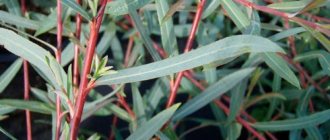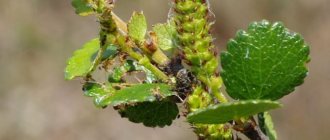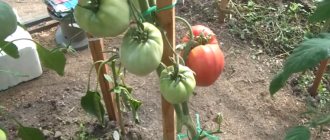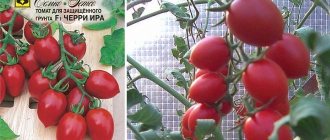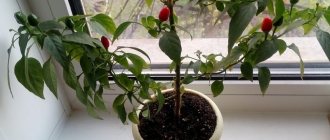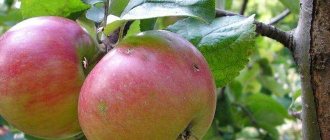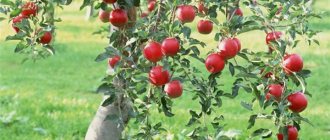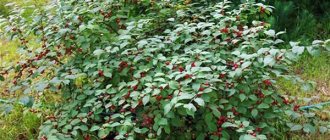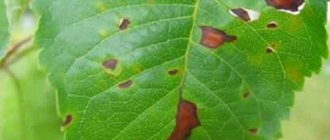Bushes and trees
0
376
Article rating
Kira Stoletova
Belobok spruce (Picea pungens Bialobok) is a popular beauty with a spectacular needle color. In the thirties of the 20th century, a Polish breeder named Bialobok noticed and fixed an interesting mutation of the Colorado blue spruce. The variety was named after him (although many people associate the name of the Christmas tree with its “white sides”).
Prickly spruce Belobok is a unique plant with an unusual color of needles
general characteristics
The Belobok Christmas tree grows slowly, but reaches a fairly large size. Tree height – 3-5 m, crown width – 200-300 cm. Shape – wide, conical, not always symmetrical.
The needles are bluish-silver in the middle, and stand out at the tips, where they are bright, white-yellow - this gives it an elegant look. Growth appears in spring.
The needles are dense and hard, up to 30 mm in length. Young cones are red and then turn brown (size - from 6 to 10 cm). The branches are directed horizontally. The lifespan of this species is 400-500 years.
Growing regions
The Christmas tree is highly winter hardy. It is recommended to grow it in regions of the 4th frost resistance zone and in warmer areas (at temperatures up to -34°C).
In Russia, these conditions correspond to Moscow and the Moscow region, St. Petersburg, Smolensk, Bryansk, Astrakhan regions, etc.
Spruce Bialobok
Belobok spruce, or Bialobok spruce (Picea pungens Bialobok) is a Polish variety of dwarf prickly spruce, bred at the beginning of the 20th century by the Polish breeder Jan Bialobok.
Its name comes precisely from the surname of the breeder, and not from the features of its appearance, as many believe. Spruce is a slow-growing, dwarf variety.
Over the course of a year, it grows only 10-12 cm; at 10 years of age, the height of the spruce is a maximum of 2-3 meters, and the width of the crown is 1 m. Spruce Bialobok lives 400-500 years, reaching more than 5 meters in height and 3 meters in diameter.
Description of the species
Prickly spruce Bialobok has an unusual appearance. The main attractiveness of the variety is the color of its crown. Spruce needles have a green-blue color, and the young growth that appears in the spring is painted white-golden, lasting almost a month. It is precisely this unique beauty of spring colors that has made the Bialobok spruce a favorite among amateur gardeners and landscape designers.
Spruce needles are 3 cm long, sickle-shaped, arranged radially. The crown is located horizontally, thick and lush, cone-shaped. At a young age it may be asymmetrical, but it evens out with age.
The lower tier is located close to the ground and does not become exposed with age. The cones are brown or red in color, can be male or female; when ripe, they turn green, up to 10 cm long, and do not appear on spruce every year.
Spreading
White-sided spruce is an artificially bred decorative variety of prickly spruce, quite winter-hardy. Therefore, the favorable habitat for its growth is zone 4 of frost resistance, which can withstand down to -34 °C. In Russia, these are the regions of Moscow, Bryansk, Smolensk, Astrakhan regions and St. Petersburg.
Reproduction
Bialobok spruce can be propagated by cuttings, sowing seeds and grafting. When sowing, the variety of the plant is not always preserved.
The cutting method allows you to propagate prickly spruce while maintaining the grade, but the survival rate of cuttings is low - 40-50%. Grafting is a more complex method of propagation, but reliable.
Vaccination is carried out in nurseries by specialists. It is very difficult to perform this procedure on your own.
Cuttings are cut from a mother plant that has reached ten years of age. The cutting should have a heel with bark, which will ensure the future slimness of the young plant. Small cuts are made on the heel for better rooting.
The cuttings are immersed in a root solution, after which they are planted in containers in a prepared soil mixture consisting of peat, leaf soil and sand. A drainage layer is poured onto the bottom of the container to remove excess moisture. The seedlings are placed in a dark place.
To ensure faster rooting, the soil is regularly heated.
For sowing, take ripe spruce cones and dry them. When the cone dries, it opens. The seeds are taken out from under the scales and soaked in a pink solution of potassium permanganate to swell.
Then the seeds are planted in trays with prepared soil mixture, the same as for cuttings. Cover with a thin layer of soil and water. The tray is covered with film and placed in a greenhouse. The seedlings germinate within a month.
The best time for sowing is the end of February.
Among the emerging seedlings, you need to select the strongest and most even specimens. Weak, twisted and diseased seedlings are removed. To successfully grow from seeds, it is necessary to maintain moist air. The optimal temperature is 15 degrees.
After warming, the seedlings need to be taken out into the open air for hardening, and in case of frost, brought into a warm place. When the first needles appear on the seedlings, they need fertilizer for coniferous plants. The bright sun can cause burns on young needles, so they need to be shaded.
After planting in open ground, seedlings are insulated for the first two years by sprinkling the tree trunk with peat. Older plants do not require insulation.
Use in landscape design
Prickly spruce bialobok looks great both in single plantings and in groups with other trees in landscape compositions.
Spruce is planted near evergreen monochromatic perennials, against which it stands out with its bright, unusual appearance.
It looks original in a composition with colorful flowers of a Japanese garden, on rocky hills, rock gardens, in combination with large stones and mountain plants.
Spruce planted in a group will wonderfully decorate courtyards located on terraces next to artificial ponds. A group of bilobok spruce trees can be used to make a hedge. Spruce can be grown in containers for up to 10 years. Such a tree can be moved from place to place, changing the appearance of the landscape, decorating terraces or facades.
The unusual colors of spruce, changing with the seasons, have made it very popular in landscape design. A beautiful and elegant tree is often used in garden design as a New Year tree, decorated with toys and garlands. Care should be taken when using light bulbs in garlands, as they can burn young spruce needles.
Diseases and pests
Despite the good resistance of spruce bialbok to growing conditions, it, like other coniferous plants, is still susceptible to diseases and attacks by pests. Most often, spruce suffers from rust and fungal diseases. These are fusarium, schutte, stem and root rot, spruce rot, which can not only spoil the appearance of the spruce, but also lead to its death.
The spruce gets sick due to improper, too deep planting, lack of water or waterlogging, lack of nutrients. When the shutte is infected, the needles turn yellow or become whitish and fall off. The disease greatly reduces the winter hardiness of spruce.
Fusarium affects the roots of a tree, penetrating all its tissues, as a result of which the needles turn brown and fall off. When infected with root or stem rot, spruce shoots dry out, and caps of mushrooms grow on the trunk.
Through the roots, infection penetrates into the wood of the plant and leads to its death.
For the prevention and control of diseases, sanitary pruning of diseased branches and irrigation of the crown during the hot period are necessary.
When the first signs of the disease appear, such as the appearance of brown spots on the needles and their falling off, the appearance of fungi, growths, and ulcers on the trunk, treatment with fungicides, for example, the drug “Cumulus” is necessary.
A diseased tree is watered abundantly at the root with a special solution of fungicides, and in the spring the crown is sprayed with preparations containing copper.
The most common pests that attack bialobok spruce are aphids, scale insects, and hermes. Aphids are bred by ants. To combat aphids, the tree is washed with a soapy solution, the treatment is carried out once a week, at least 3 times. The spread of ants must not be allowed, otherwise the fight against aphids will be in vain. Hermes infects spruce needles.
It turns yellow, a sticky coating forms on its lower part, and at the ends of the shoots there are galls in which Hermes larvae are located. Branches affected by this pest dry out. The scale insect sucks juices from young plants, and when it attacks an adult spruce, it retards its growth and deforms it.
To combat Hermes, which causes curvature of shoots, as well as scale insects, systemic insecticides “Funafon” or “Ragor” are used.
Using all available methods of pest and disease control, as well as following all the rules of agricultural technology, you will get a luxurious, exceptionally beautiful spruce that will delight the eye for many years.
Source: https://lesoteka.com/derevya/el-bialobok
Botanical description of the tree
Spruce belongs to the genus of evergreen coniferous trees of the Pine family. In total, there are about 40 species of them with different heights, colors and crown shapes. The variety Belobok, or Bialobok (Picea pungens Bialobok) is a slow-growing ornamental tree with blue needles.
On average, by the age of ten, the width of the spruce reaches 2 m and the height 2.5 m.
The tree becomes especially decorative at the beginning of spring, when young light tips appear on top of the old dark shoots. Young shoots first acquire a creamy, then bright creamy color, and after 5 weeks they “even out” in color with last year’s branches.
It is the contrast of blue and light that is the “trump card” of the variety. The shape of the crown can change during growth from hemispherical to cone-shaped. The male cones are large, dark brown, and the female cones are brown or red-brown, up to 10 cm long.
Check out the most common varieties of blue spruce.
The needles are dense and prickly, reaching a size of 3 cm. The tree has a wide root system with its superficial location. Belobok spruce is unpretentious in care and is tolerant of urban conditions, so designers prefer it for its compactness, spectacular combination of blue color with other plants and frost resistance.
origin of name
There is a mistaken belief that the name “Belobok” comes from the word “white-sided” in connection with the unusual color of the tree. However, the facts indicate the opposite. Almost a century ago, in the 30s of the last century, Polish gardener Jan Bialobok discovered a mutated specimen of pine needles.
The decorative appearance and compact size took their toll, so the gardener decided to preserve the variety for use in landscape design, after which it began to be called by the name of the breeder. Further research and propagation of prickly spruce was carried out in the area of the Polish city of Kurnik.
Spruce care
Belobok spruce is not a demanding tree, however, it also needs timely care, which consists in adhering to the rules of agricultural technology (for example, with excessive watering, the needles can become a victim of root rot, which will then spread to neighboring plants, and if they do not receive enough vitamins, they can weaken and lose immunity against pests).
It is important to constantly monitor the condition of the earthen clod, which should not become waterlogged or dry out. That is why, when planning to use blue spruce in the landscape design of your home, it is better to purchase seedlings at a garden center or in specialized stores that provide careful and timely care for plants.
In urban conditions, taking care of the tree and creating a watering regime is done in advance, and if the condition of the plants deviates from the norm, recommendations for their resuscitation are given to service workers.
Source: https://fermer.blog/bok/hvoynye-derevya/el/raznovidnosti-eli/golubaya-el/14533-el-belobok.html
Landing
You need to choose seedlings with a closed root system. In this form, they are better preserved and take root, and in addition, they can be planted at any time.
The soil in the container should be sufficiently moist, and the tree itself should have dense needles, firmly attached to the branches, and a healthy natural color.
Landing location
Beloboka spruce loves sunny areas, but can also grow in partial shade. In the latter case, its needles turn out to be less bright.
The tree feels good on well-drained, moderately moist loams with an acidic reaction. Does not tolerate soil salinity, excessive dryness and waterlogging.
Landing technology
The planting hole is dug one and a half to two times larger than the earthen ball of the seedling. Garden soil is mixed with peat, sand, and fertilizers for conifers. A drainage layer (15-20 cm) of broken brick, expanded clay or sand is placed in the hole. Pour in water and let it soak.
In the sun the needles will appear in all their glory
The plant is installed so that the root collar is at ground level, sprinkled with part of the substrate, and watered abundantly. Then they are covered with earth again, gradually compacting so that the roots come into contact with the soil. The tree trunk circle is mulched with peat, dry leaves or pine needles.
Dwarf white-sided spruce: not quite dwarf, not always white
Not a classic large tree, not a forest beauty - the white-sided spruce grows only up to 2-3 m. Spectacular due to its creamy, straw-colored spring shoots, it has taken a special place in the niche of dwarf crops.
Connoisseurs of coniferous species will be interested in the description of the form, detailed characteristics, and subtleties of agricultural technology.
Those looking at a miniature tree - photos and possibilities of use in garden and park compositions.
General information, morphological description
White-sided spruce, also known as Bialobok (Picea pungens Bialobok) is a dwarf (semi-dwarf) variety of prickly spruce. Bred in 1939 in Lublin (Poland), it was named after the breeder, Jan Bialobok, head of the PINGW arboretum (State Economic Institute of Agricultural Poland).
Used in group plantings and single plantings (like tapeworm), for landscaping terraces, in rocky gardens, rock gardens. It is also grown in hill culture, in containers.
It belongs to the slow-growing varieties: the annual growth is small - about 12 cm. According to Polish sources, spruce trees older than 10 years reach a non-dwarf height of 5 m with an impressive crown diameter of up to 3 m.
Light young twigs
In the first years, the crown is without a pronounced trunk, hemispherical, asymmetrical (irregular), with age it becomes broadly cone-shaped and cone-shaped. The shoots are horizontal, hard, short. Mature trees retain the branches of the lower tiers; the trunk is not exposed.
The needles of the white-sided spruce are silver-blue, crescent-shaped, dense, hard, with an ash-silver coating. The length of thick, radially arranged needles is up to 3 cm. In spring, young growth is painted a creamy, straw color for 2-3 weeks.
The swollen buds are first covered with dry translucent scales. As they fly around, they reveal delicate milky white growths that contrast with the blue needles. Cones of the white-sided spruce variety are male and female, 5-10 cm long.
Males are brown-brown, females are red-brown.
Attention! For the first two to three years, the plant is not used as a New Year's garden decoration. Weighting and mechanical impact negatively affect young growth and needles. The tree cannot be hung with electric garlands: heating bulbs leave yellow burn marks on the needles.
Growing: basic requirements
- Illumination. Light-loving, shade-tolerant, but not shade-loving. The best location is with full exposure to the sun. With partial shading, the needles lose their color saturation. Young plants are shaded - burns are possible in the spring sun.
- Priming. Fertile, permeable, well-drained, without stagnant water - from black soil, sandy loam to loam. pH reaction – acidic, slightly acidic. Negatively relates to soil compaction and water stagnation.
- Watering. Loves moderately moist soil. In hot weather, spruce trees up to 2 years old are watered weekly - about 10 liters per tree. As the root grows and reaches deeper layers of the soil, the need for watering the spruce is reduced.
- Reproduction is carried out by cuttings, less often by seeds. With the latter, the parental traits of the variety may not be preserved. When propagated by cuttings, the survival rate is slightly above 50%. It is possible to propagate by grafting onto tall species, which is practiced by many nurseries.
- Frost resistance. Winter hardiness is high, recommended climate zone 4.
Attention! In areas with harsh winters, young spruce trees are covered with burlap or agro-fabric to avoid late winter and spring needle burns.
When planning a garden, the distance of the spruce from neighboring crops is calculated. A low dwarf tree reaches a diameter of 3 meters with age.
The new dimensions of a tall tree will disrupt the garden composition, and the plants will suffer when the feeding area is reduced and in the shade.
Advice! The asymmetrical shape of the crown of a young spruce and its certain curvature is corrected by tying it to the supports, setting the direction of growth.
Planting and care
For spruce, choose a well-lit area with permeable, well-drained soil. During the event, simple rules are followed:
- depth of planting nests m up to 70 cm;
- distance in group plantings – up to 3 m;
- planting holes for white-sided spruce are filled with a soil mixture of turf and leaf soil with a mixture of sand and peat (2:2:1:1);
- organize drainage from sand and pebbles up to 20 cm thick;
- on poor soil it is possible to apply nitroammophoska and other NPK complex fertilizers;
- the seedling is transferred from the container without disturbing the earth;
- After planting, the spruce is watered and mulched with peat.
Attention! When planting spruce, the root collar is placed almost flush with the ground.
Care comes down to superficial loosening of the tree trunk circle and infrequent watering. As for fertilizing, fertilizer for conifers is applied twice a season under the dwarf spruce.
At the beginning of summer, sanitary pruning is carried out. The spruce does not need forming: it is not a shrub, the event does not stimulate lateral branching.
Trimming the crown will cripple the plant - the top will not grow back, and cutting off young growth does not guarantee correction of the crown.
In addition, the plant keeps needles on old branches for about 3 years, the growth is small, and losses after pruning are replenished for many years. In the fall, be sure to carry out pre-winter watering and mulch with peat.
Diseases and pests are common to conifers. Among the diseases, spruce is affected by rust, which covers the needles with red spots. Young trees are at risk of the fungal disease Schutte - shedding of needles and wilting of shoots.
Among the pests, the dangerous insect attacks the spruce sawfly, and a type of aphid, the spruce-fir Hermes. To protect the tree from fungus, copper preparations and colloidal sulfur are used.
Insecticides (ragor, funafon, etc.) will protect against sawfly and hermes.
In general, the miniature beauty is considered a trouble-free variety. It is not demanding on the composition of the soil, it acclimatizes well, and care comes down to basic measures. In its homeland, Poland, spruce is less common than new decorative forms. But the miniature beauty has moved into our gardens, where in winter it delights with gray blue needles and announces the arrival of spring with its creamy fluffy “paws.”
White-sided spruce: video
Source: https://sad24.ru/derevya/karlikovaya-el-beloboka.html
Care
The prickly tree is not too demanding to care for. She needs regular watering, mulching, and fertilizing.
There are very few rules, but it is better not to neglect them in order not only to promote the growth of the Christmas tree, but also to create a natural prevention of diseases.
Watering
The tree is watered weekly, using 10-12 liters of water for an adult plant and 6-7 for a young seedling. When watering, you need to focus on the weather and soil moisture: in the rainy season they are done less often, in the dry season - 2-3 times a week.
The plant responds well to evening sprinkling of the crown.
Feeding
The tree is fed 2 times a season - in early spring and in August. The easiest way is to use special complexes for conifers. If there is a deficiency of a particular mineral, foliar feeding is used.
Gardeners often lean toward drugs like Epin, which not only nourish but also strengthen the plant’s immunity.
Mulching and loosening
The Christmas tree has an extensive but superficial root system, so loosening the soil is carried out shallowly (up to 5-6 cm). An important part of care is mulching, as this allows you to normalize the level of humidity, gives access to air, maintains acidity, and reduces the number of weeds.
The tree trunk circle can be mulched with peat, dry leaves, pine needles, sawdust or wood chips, small cones, and bark.
Trimming
The Christmas tree needs annual sanitary pruning, which is carried out in the spring, before the buds begin to grow. At the same time, dry and damaged branches are removed. It is better to do a shaping haircut at the end of summer or in September.
The shaping should be moderate - you cannot deprive the tree of more than a third of the total green mass.
Preparing for winter
Belobok prickly spruce is distinguished by strong, tough and moderately short shoots that do not break under the weight of snowballs. Given its good frost resistance, an adult tree needs only minimal protection - a thickened layer of peat in the tree trunk.
However, it is better to protect young seedlings from snow, wind and possible burns by wearing burlap or special covers.
Features of agricultural technology
Belobok spruce is a strong, unpretentious plant. It loves sunlight, and it is in such areas that spring growth is especially bright. But it can also grow in partial shade, losing some of its charm.
Copes well with air pollution in urban environments. Prefers slightly acidic, well-drained soils, reacts negatively to excess organic matter and mineral fertilizers.
It tolerates pruning well and needs it at times, especially if the crown begins to lose its symmetry. It does not tolerate soil salinity, stagnation of water near the roots, or excessive soil compaction, so the tree trunk circle should be periodically loosened and mulched.
Winter hardiness is high; in the middle zone it does not require shelter. It is not susceptible to common diseases and pests, especially with proper care.
Reproduction
Spruce can be propagated by seeds and cuttings
The Christmas tree can be propagated by cuttings and seeds. Sometimes cuttings are grafted onto the rootstock of other coniferous trees. Both methods have advantages and disadvantages.
Seeds do not always produce spruce trees with the desired varietal properties. Vegetative propagation allows you to preserve the characteristics of the variety, but judging by reviews, approximately 40-50% of planted cuttings take root.
To increase the chances, it is necessary to use growth stimulants (Kornevin) and special nutrient substrates.
Diseases and pests
The most common insect pests are spruce sawfly and aphids. The tree should be frequently inspected for infestation, and at the first sign, washed with a solution of laundry soap. In serious cases, it is necessary to resort to insecticides.
Overmoistening of the soil can provoke fungal diseases - rust and Schutte. For prevention, spruce trees are sprayed with Bordeaux mixture. Having detected a disease, copper-containing preparations and other fungicides are added to it.
In landscape design
Thanks to its beautiful contrasting color, the Belobok Christmas tree is very popular in landscape design. In addition, new growth appears only in the spring, which allows it to successfully change its appearance.
The tree harmonizes perfectly with flowers and is often used in rockeries. It is better to plant it among monochromatic green trees, playing the role of a bright accent and not distracting attention in any way.
For the first 10 years of its life, spruce can grow in a container and be used to decorate terraces or facades. It looks very beautiful in rock gardens, rocky gardens, and compositions with ponds.
Description of appearance
Interesting! In Russian-language literature one can often come across a judgment that the name of the variety is associated precisely with such white sides of spruce. As we already know, this is not true.
There is another false opinion about this variety. It is often called a dwarf variety. Indeed, in the first decade it develops slowly, growing during this time by only 1.5 - 2 meters. But unlike real dwarfs, this spruce continues to grow. At the age of 30−40 years, it can reach a height of several meters. Agree, you can’t call it dwarfism! We are dealing with a medium-sized spruce, the diameter of which at a mature age can reach three meters.
Thanks to what qualities did Mr. Byalobok decide to keep the specimen? The fact is that it had unusual young shoots: creamy yellow, almost straw-colored. They retain this color for 5-6 weeks, and during this time the Belobok spruce looks like a beauty with which few can compete in the spruce kingdom. The spring combination of cream, yellow, and bluish shades of pine needles creates an unsurpassed effect!
Interesting! In Russian-language literature one can often come across a judgment that the name of the variety is associated precisely with such white sides of spruce. As we already know, this is not true.
There is another false opinion about this variety. It is often called a dwarf variety. Indeed, in the first decade it develops slowly, growing during this time by only 1.5 - 2 meters. But unlike real dwarfs, this spruce continues to grow. At the age of 30−40 years, it can reach a height of several meters. Agree, you can’t call it dwarfism! We are dealing with a medium-sized spruce, the diameter of which at a mature age can reach three meters.
Reviews
The Christmas tree attracts the sympathy of most conifer lovers; it is distinguished by its spectacular appearance, slow growth and ease of care. According to the description, it tolerates winters, pruning and replanting well, but is sensitive to waterlogging.
Some note that the tree grows no more than 2 m (but it is worth considering that with such a long life span the plant may still be).
Some gardeners complain about the rarity of this variety and the relatively high price. Small seedlings (up to 50 cm) cost about 5-7 thousand rubles, and are not found in all nurseries.
